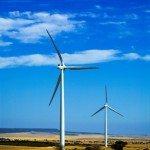Australia’s largest listed renewable energy company has dismissed as a “bluff” the threats by major electricity retailers to effectively “boycott” renewable energy projects and pay a “penalty” price rather than build new wind or solar farms in Australia.
Infigen Energy said the threats by both Origin Energy and AGL Energy – if implemented – could amount to a collusive boycott that would attract the interest of competition regulators.
 But CEO Miles George says it is probably just a bluff in any case. If the retailers did choose to pay the penalty price, or $92.50/MWh, that would be way more than needed by the likes of Infigen and others to finance new wind and solar farms.
But CEO Miles George says it is probably just a bluff in any case. If the retailers did choose to pay the penalty price, or $92.50/MWh, that would be way more than needed by the likes of Infigen and others to finance new wind and solar farms.
“The concept is illogical,” George told RenewEconomy in an interview after announcing his company’s interim results on Wednesday. “The penalty price is (nearly) $93, we would be happy to sell LGCs (renewable energy certificates) at much less than that.”
George said the threat might be more about a desire to protect fossil fuel generating assets, but would disadvantage the retailers’ own customers. “I think it is an idle threat,” he said.
Asked why it got such airplay with the government – environment minister Greg Hunt has cited the penalty price numerous times in arguing for the RET to be cut – George said: “It gets a lot of airplay because of the threat of doing it collusively. If they (the retailers) do collude to do that, then I think the ACCC should be involved.”
George indicated that renewable energy developers may get around the utility disinterest by going straight to the corporate market for direct offtake agreements – as is now common in the US and Europe, with Apple, Google, and GM all announcing in the past week that they will be funding wind and solar farms. Pattern Energy announced overnight that it has entered a deal to build 1,000MW of wind and solar energy with cement giant Cemex.
 However, George said the Australian corporate market was also waiting for clarity on the RET from the Abbott government.
However, George said the Australian corporate market was also waiting for clarity on the RET from the Abbott government.
George lamented the fact that it had been one year since the Abbott government formally launched its RET enquiry, led by climate denier and pro-nuclear advocate Dick Warburton, and six months since the review was completed and found no adverse impact on prices.
Since then, the government appeared to have changed position twice – from countenancing a complete end to the RET, to trying to limit it to a “real 20 per cent” or 27,000GWh, to a new position in the low 30,000Gwhs.
The current target stands at 41,000GWh, and with a likely compromise on excluding trade exposed industries such as aluminium smelters – despite AGL Energy saying this month the aluminium smelter was doing so well some ageing smelters were likely to stay open an extra decade – to pull the target back to 38,000GWh.
Still, until the impasse over policy is resolved, nothing will get built. Despite this, the market was taking a more positive view, with electricity futures and certificate futures both indicating rises.
George says once the impasse is broken, then there should be no problems meeting even the current target. The movement in electricity price futures and renewable energy certificates meant that the “best” renewable energy projects would get built, although other projects would require higher prices.
This table below indicates the latest market prices. South Australia is facing higher prices because it is more reliant on gas, where gas prices are forecast to rise. (This is despite AGL deciding to close half its gas capacity there).
George said LGCs were now trading in the low $40s/MWh, above the $30/MWh lows of last year, but still well short of the $50/MWh needed for substantial new development.
The key will be around the timing of any decisions. The government appears in no hurry, with only a few weeks of parliament scheduled before the May budget.
One factor that may spark a resolution is the situation of the trade exposed industries, such as aluminium, which would need to know by mid-March if they have an obligation to meet in the next financial year.
Because of the impasse over the RET, Infigen Energy has now geared its expenditure 70-30 per cent in favour of the US over Australia, reversing its previous position.
“It’s a complete contrast to the US,” George said of the Australian policy environment. Infigen has more than half its assets in the US, which is supported by robust state-based targets and that growing corporate interest in renewables.
Indeed, Infigen’s main growth area is in large-scale solar projects. Last financial year it sold two 20MW solar projects in the US, and in the last few months has secured power purchase agreements for another two 20MW solar projects, anda 15MW solar project.
George said the company is now looking at how to go forward with those projects. Judging by previous comments, a sale of the ready-to-go projects looks the most likely.








